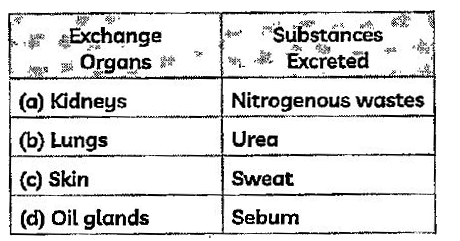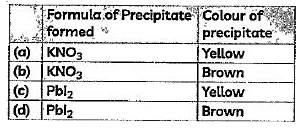
According to the ‘Solid Waste Management Rule 2016’, the waste should be segregated into three categories. Observe the table below and select the row that has correct information

The correct Answer is:B
Step by step video & image solution for According to the ‘Solid Waste Management Rule 2016’, the waste should be segregated into three categories. Observe the table below and select the row that has correct information by Physics experts to help you in doubts & scoring excellent marks in Class 10 exams.
Updated on:21/07/2023Topper's Solved these Questions
- QUESTION BANK 2021Book:CBSE MODEL PAPERChapter:QUESTION BANK 2021Exercise:PROBABILITY (Case Study 2)
Explore 5 Videos
- PRACTICE PAPER 2022Book:CBSE MODEL PAPERChapter:PRACTICE PAPER 2022Exercise:Multiple Choice Questions
Explore 60 Videos
- SAMPLE PAPER (MATHEMATICS STANDARD)Book:CBSE MODEL PAPERChapter:SAMPLE PAPER (MATHEMATICS STANDARD)Exercise:PART - B
Explore 16 Videos
Similar Questions
Observe the following diagram

According to the 'Solid Waste Management Rule 2016' , the waste should be segregrated into three categories. Observe the table below and select the row that has correct information

View SolutionStudy the table below and select the row that has the correct information:

View Solution
Knowledge Check
All living cells require energy for various activities. This energy is available by the breakdown of simple carbohydrates either using oxygen or without using oxygen.
Study the table below and select the row that has the incorrect information.AAerobic AnaerobicaLocation Cytoplasm MitochondriaBAerobic AnaerobicbEnd ProductCO2 and H20Ethanol andCO2CAerobic AnaerobiccAmount of ATP HighLowDAerobic AnaerobicdOxygen Needed Not neededThe e-waste (Management and Handling) Rules. 2011, notified by the Ministry of Environment and Forests, have the potential to turn a growing problem into a developmental opportunity. With almost half-a-year to go before the rules take effect, there is enough time to create the necessary infrastructure for collection. dismantling and recycling of electronie waste. The focus must be on sincere and efficient implementation. Only decisive action can reduce the pollution and health costs associated with India's hazardous waste recycling industry. If India can achieve a transformation, it will be creating a whole new employment sector that provides good wages and working conditions for tens of thousands. The legacy response of the States to even the basic law on urban waste, the Municipal Solid Wastes (Management and Handling) Rules has been one of indifference, many cities continue to simply burn the garbage or dump it in lakes. With the emphasis now on segregation of waste at source and recovery of materials. it should be feasible to implement both sets of rules efficiently. A welcome feature of the new ewaste rules is the emphasis on extended producer responsibility. In other words, producers must,take responsbility for the disposal of end of-life products For this provision to work, they must ensure that consumers who sell scrap get some form of financial incentive,
The e-waste rules, which derive from those pertaining to hazardous waste, are scheduled to come into force on May· 1, 2012. Sound as they are, the task of scientifically disposing a few hundred thousand tonnes of trash electronics annually depends heavily on a system of oversight by State Pollutions Control Boards:(PCBs). Unfortunately, most PCBs remain unaccountable and often lack the resources for active enforcement. It must be pointed out that although agencies handling e-waste must obtain environmental clearances and be authorised and registered by the PCBs even under the Hazardous Wastes (Management, Handling and Transboundary Movement) Rules 2008, there has been little prnctical impact. Over 95 per cent of electronic waste is collected and recycled by the informal sector. The way forward is for the PCBs to be made accountable for enforcement of thee- waste rules and the levy of penalties under environmental laws. Clearly, the first order priority is to create a system that will absorb the sn,oo0-strong workforce in the informal sector into the proposed scheme for scientific recycling. Facilities must be . · created to upgrade' the skills of these workers through training and' their occupational health must be ensured.
Recycling ofo-wasteis one of the biggest challenges today. In such 'a time, when globalisation and information technology are growing at a pace which could only be imagined few years back, e-waste and its hazards have become more prominent over a period of time arid should be given immediate attention.
Which of the following can be one of the by-products of effective e-waste management?AIndia can guide other countries in doing so.BIt will promote international understanding.CIt will promote national integrationDIt will create a new employment sector.The e-waste (Management and Handling) Rules. 2011, notified by the Ministry of Environment and Forests, have the potential to turn a growing problem into a developmental opportunity. With almost half-a-year to go before the rules take effect, there is enough time to create the necessary infrastructure for collection. dismantling and recycling of electronie waste. The focus must be on sincere and efficient implementation. Only decisive action can reduce the pollution and health costs associated with India's hazardous waste recycling industry. If India can achieve a transformation, it will be creating a whole new employment sector that provides good wages and working conditions for tens of thousands. The legacy response of the States to even the basic law on urban waste, the Municipal Solid Wastes (Management and Handling) Rules has been one of indifference, many cities continue to simply burn the garbage or dump it in lakes. With the emphasis now on segregation of waste at source and recovery of materials. it should be feasible to implement both sets of rules efficiently. A welcome feature of the new ewaste rules is the emphasis on extended producer responsibility. In other words, producers must,take responsbility for the disposal of end of-life products For this provision to work, they must ensure that consumers who sell scrap get some form of financial incentive,
The e-waste rules, which derive from those pertaining to hazardous waste, are scheduled to come into force on May· 1, 2012. Sound as they are, the task of scientifically disposing a few hundred thousand tonnes of trash electronics annually depends heavily on a system of oversight by State Pollutions Control Boards:(PCBs). Unfortunately, most PCBs remain unaccountable and often lack the resources for active enforcement. It must be pointed out that although agencies handling e-waste must obtain environmental clearances and be authorised and registered by the PCBs even under the Hazardous Wastes (Management, Handling and Transboundary Movement) Rules 2008, there has been little prnctical impact. Over 95 per cent of electronic waste is collected and recycled by the informal sector. The way forward is for the PCBs to be made accountable for enforcement of thee- waste rules and the levy of penalties under environmental laws. Clearly, the first order priority is to create a system that will absorb the sn,oo0-strong workforce in the informal sector into the proposed scheme for scientific recycling. Facilities must be . · created to upgrade' the skills of these workers through training and' their occupational health must be ensured.
Recycling ofo-wasteis one of the biggest challenges today. In such 'a time, when globalisation and information technology are growing at a pace which could only be imagined few years back, e-waste and its hazards have become more prominent over a period of time arid should be given immediate attention.
What, according to the passage, is important now for ewaste management?AMaking rulesBReviewing rulesCImplementingrulesDNotifyingrules
Identify the substances marked X and Y from the figure below and select the row containing correct information:


View SolutionCase 2 : the biological process involved in the removal of harmful metabolic wastes from the bosy is called excertion .Different organisms use varied strategies to do this Many unicellular organisms remove these wastes by simple diffusion from the body surface into the surrounding water while complex multicellular organisms use specialised organs to perform the same function .
Study the table below and select the incorrect match .

View SolutionPotassium iodide solution is added to lead nitrate solution in a test tube. Select the correct observation from the table below:

View SolutionGiven below is the process to separate the contents of a living tissue by acid treatment and a list of certain observations . Segregate the observations under filtrate (A) and retentate (B) and select the correct combination .

1. Molecular weight ranging from 18 - 800 daltons approx.
2. Proteins, nucleic acids , polysaccharides and lipids
3. Chemicals more than 800 daltons molecular weight
4. Has monomers
5. Generally has polymers
View SolutionThe e-waste (Management and Handling) Rules. 2011, notified by the Ministry of Environment and Forests, have the potential to turn a growing problem into a developmental opportunity. With almost half-a-year to go before the rules take effect, there is enough time to create the necessary infrastructure for collection. dismantling and recycling of electronie waste. The focus must be on sincere and efficient implementation. Only decisive action can reduce the pollution and health costs associated with India's hazardous waste recycling industry. If India can achieve a transformation, it will be creating a whole new employment sector that provides good wages and working conditions for tens of thousands. The legacy response of the States to even the basic law on urban waste, the Municipal Solid Wastes (Management and Handling) Rules has been one of indifference, many cities continue to simply burn the garbage or dump it in lakes. With the emphasis now on segregation of waste at source and recovery of materials. it should be feasible to implement both sets of rules efficiently. A welcome feature of the new ewaste rules is the emphasis on extended producer responsibility. In other words, producers must,take responsbility for the disposal of end of-life products For this provision to work, they must ensure that consumers who sell scrap get some form of financial incentive,
The e-waste rules, which derive from those pertaining to hazardous waste, are scheduled to come into force on May· 1, 2012. Sound as they are, the task of scientifically disposing a few hundred thousand tonnes of trash electronics annually depends heavily on a system of oversight by State Pollutions Control Boards:(PCBs). Unfortunately, most PCBs remain unaccountable and often lack the resources for active enforcement. It must be pointed out that although agencies handling e-waste must obtain environmental clearances and be authorised and registered by the PCBs even under the Hazardous Wastes (Management, Handling and Transboundary Movement) Rules 2008, there has been little prnctical impact. Over 95 per cent of electronic waste is collected and recycled by the informal sector. The way forward is for the PCBs to be made accountable for enforcement of thee- waste rules and the levy of penalties under environmental laws. Clearly, the first order priority is to create a system that will absorb the sn,oo0-strong workforce in the informal sector into the proposed scheme for scientific recycling. Facilities must be . · created to upgrade' the skills of these workers through training and' their occupational health must be ensured.
Recycling ofo-wasteis one of the biggest challenges today. In such 'a time, when globalisation and information technology are growing at a pace which could only be imagined few years back, e-waste and its hazards have become more prominent over a period of time arid should be given immediate attention.
Which of the following will help implement "both sets of rules"?
View Solution